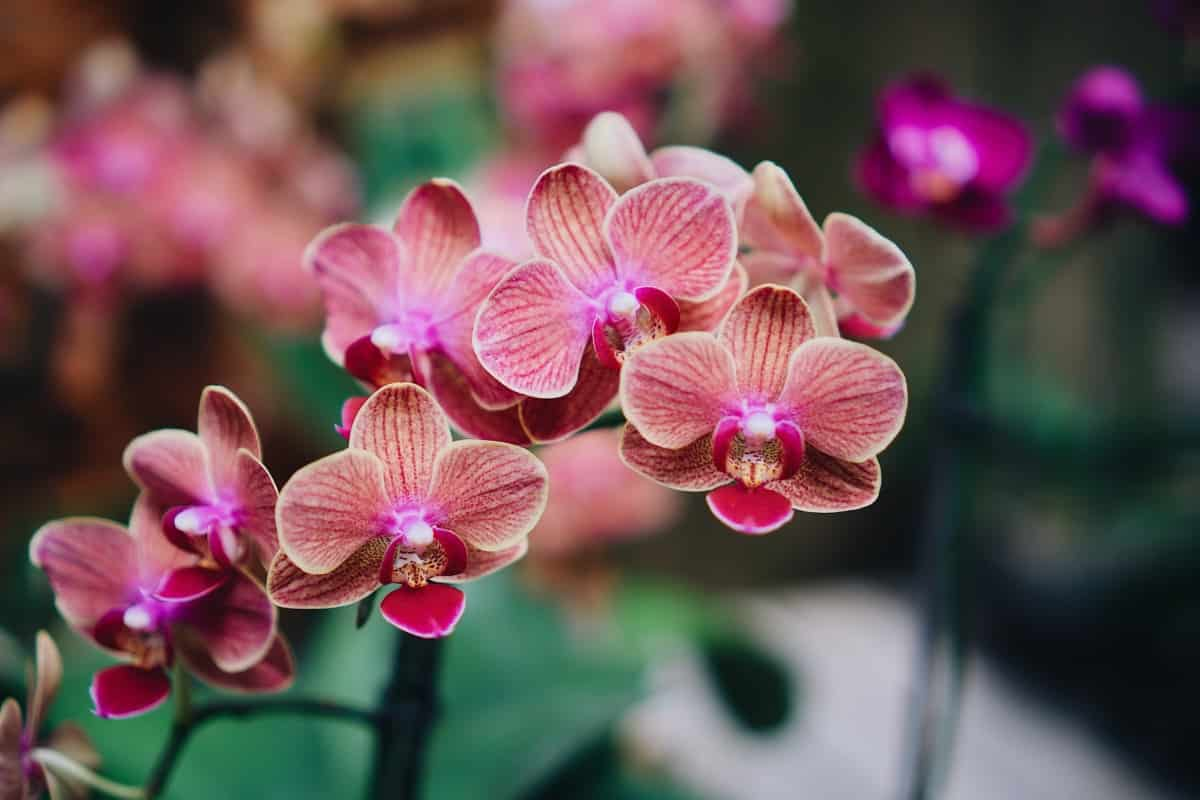Welcome to our blog on growing orchids hydroponically! This post will explore the intriguing question: Can orchids grow in water? Orchids are known for their delicate beauty, and the idea of growing them in a water-based hydroponic system may seem unusual. However, with the right techniques and care, orchids can thrive without soil. Let’s check out more information on how to grow Orchids hydroponically below.

How to Grow Orchids Hydroponically in Water: Step-by-step Guide on
- Selecting the Orchid Variety: Choose orchid varieties suitable for hydroponic growth. Popular choices include Phalaenopsis, Dendrobium, and Cymbidium orchids.
- Water-based Hydroponic Setup: Set up a water-based hydroponic system for your orchids. This can be done using a reservoir, an air pump, and an air stone to oxygenate the water.
- Nutrient Solution Preparation: Prepare a nutrient solution specifically formulated for orchids. This solution should contain essential macronutrients (nitrogen, phosphorus, and potassium) and micronutrients (iron, manganese, zinc, etc.) required for healthy growth.
- pH Level Management: Monitor and maintain the pH level of the nutrient solution between 5.5 and 6.5, as orchids prefer a slightly acidic environment. Use pH testing kits or meters to ensure accurate measurements.
- Transplanting Orchids: Carefully remove the orchids from their current potting medium and rinse the roots under running water. Trim any damaged or dead roots and place the orchid into the hydroponic system, submerging the roots in the nutrient solution.
- Lighting and Temperature: Provide adequate lighting for your orchids, preferably using full-spectrum grow lights. Maintain the temperature between 65°F and 75°F or 18°C to 24°C during the day and slightly cooler at night.
- Monitoring and Maintenance: Regularly check the solution’s water level, nutrient concentration, and pH levels. Adjust nutrient levels and replenish water as needed. Inspect the orchids for signs of pests or diseases and take appropriate measures for control.
Best Hydroponic Systems for Growing Orchids: Hydroponic Methods for Growing Without Soil
Some of the best hydroponic systems for growing orchids include the nutrient film technique (NFT), deep water culture, and ebb and flow systems. NFT systems deliver a thin film of nutrient-rich water to the orchid roots. DWC systems submerge the orchid roots in a nutrient solution, allowing for efficient absorption. Ebb and flow systems periodically flood the orchid roots with nutrient solution and then drain it away. These systems ensure proper nutrient delivery, water oxygenation, and root health, resulting in thriving orchids.
In case you missed it: 9 Reasons for Wiliting Orchid Plants: Prevention, Treatment, and Solutions

Can Orchids Grow in Water?
- Orchids can be grown in water using a technique called water culture.
- Water culture involves soaking the orchid’s roots in water for a few days and then allowing them to dry out for a period of time.
- This method mimics the natural conditions of epiphytic orchids, which grow in minimal soil and obtain moisture from the air.
- To grow orchids in water, un-pot the plant and carefully clean and trim the roots.
- Place the orchid in a container with enough room for root growth, preferably a glass container, for easy observation.
- Clay pebbles can be used at the bottom of the container to support the roots and prevent rot.
Optimal Nutrient Solution for Hydroponic Orchids
The optimal nutrient solution for hydroponic orchids is crucial for their healthy growth and blooming. Orchids require a balanced combination of essential nutrients, including nitrogen, phosphorus, potassium, calcium, magnesium, and trace elements like iron, manganese, zinc, and copper. A recommended nutrient solution for orchids has a nitrogen-to-potassium ratio of 3:1 and a balanced pH between 5.5 and 6.5.
Hydroponic Orchid Growing Techniques
Not all orchids are suitable for hydroponic culture. The best orchids to transfer to hydroponics are newly acquired or young plants, while orchids thriving in the potting medium for years should remain the same. Epiphytic orchids adapt well to hydroponics due to their air-exposed, spongy roots, while terrestrial orchids are less compatible since their roots are designed for soil nutrient absorption.
There are two methods for growing orchids hydroponically. In full water culture, the pot contains only the roots and water, with a watering cycle alternating between wet and dry periods. Each orchid has its preferences, so experimentation is needed to determine the optimal conditions. In the semi-hydroponic method, the orchid pot sits on a layer of leca pebbles, which soak up water from a reservoir below.
The roots do not come into direct contact with the water, but humidity and hydration are maintained. Water exchange in the reservoir is required periodically. When transferring an orchid to hydroponic culture, removing all potting mediums from the roots is important, as any leftover material can promote root rot and the growth of bacteria and mold. Damaged or unhealthy roots should be trimmed, ensuring only healthy roots remain.
The choice of the pot depends on the method used. A round fishbowl-like jar with drilled holes for airflow is recommended for full water culture. A taller jar with space between the roots and the water reservoir is preferred in semi-hydroponics. Clear glass or plastic pots allow for observation of orchid growth.
Watering frequency and water quality are important considerations. Maintaining expansive air flow and using quality water is crucial in full water culture. For the semi-hydroponic method, proper water level maintenance and water quality are important for success. Signs of an orchid not adapting well to hydroponic culture include root decay, yellowing or discolored leaves indicating fungal infections, and over-watering.
Constant observation is necessary to identify and address these issues promptly. The emergence of new flowers in hydroponic orchids may not necessarily indicate success. It could be a sign of stress or the orchid’s last attempt at reproduction. Long-term observation and comparison of results are necessary to determine the effectiveness of hydroponic techniques.
In case you missed it: 9 Reasons Why Your Orchid Flowers Are Falling Off: Treatment and Solutions

Hydroponic Orchid Maintenance Tips
- Maintain proper lighting, with an ideal range of 1,500 to 2,500-foot candles. The temperature should be around 70-80°F during the day and slightly cooler at night.
- Maintain humidity levels between 50-70%. Proper air circulation is crucial to avoiding stagnant air. Monitor nutrient solution pH and EC levels regularly.
- Keep the reservoir filled with fresh, properly balanced nutrient solutions. Inspect the roots regularly, removing any decaying or damaged roots.
- Prune orchids to promote healthy growth and prevent overcrowding. Regularly clean and sterilize the growing system to prevent the buildup of algae, bacteria, and pests.
Maintaining Proper pH Levels for Water-grown Orchids
Maintaining proper pH levels is important for water-grown orchids. The ideal pH range for orchids is between 5.5 and 6.5. pH levels outside this range can hinder nutrient absorption and cause damage to the orchid’s roots. Regular monitoring and adjustment of pH are necessary for optimal growth.
Hydroponic Techniques for Promoting Healthy Root Growth in Orchids
- Oxygenation: Orchid roots need access to oxygen. Techniques like aeroponics or air stones in the nutrient solution can ensure adequate oxygen levels.
- Nutrient balance: Orchids require a balanced nutrient solution. Monitoring and adjusting the nutrient levels, including macronutrients and micronutrients, is essential for optimal root growth.
- pH level: Maintaining the appropriate pH range (5.5-6.5) is crucial for nutrient absorption. Regular monitoring and adjustment of pH levels help promote healthy root development.
- Root zone temperature: Orchid roots thrive in a specific temperature range. Maintaining root zone temperatures between 65-75°F (18-24°C) can stimulate root growth and nutrient uptake.
- Hydroponic media: Choosing the right hydroponic media, such as coconut coir, perlite, or clay pellets, provides a suitable environment for orchid roots to grow and absorb nutrients effectively.
Preventing Root Rot in Orchids Grown Hydroponically in Water
Root rot is a common problem in orchids grown hydroponically in water. To prevent root rot, it’s crucial to maintain proper oxygen levels in the water. Air pumps or air stones can aerate the water to achieve this and give the roots oxygen. Additionally, ensuring the water temperature is appropriate and avoiding overwatering are important measures to prevent root rot in hydroponic orchids.
Common Challenges and Solutions in Hydroponic Orchid Cultivation
Orchid cultivation in hydroponics faces several challenges. Nutrient imbalance can be resolved by monitoring and adjusting nutrient levels. A well-draining medium and proper drainage are necessary to prevent root rot due to excessive moisture. Pests like aphids and mites can be controlled with insecticidal soaps. Temperature and humidity fluctuations need to be stabilized using ventilation or humidifiers. Adequate lighting and pollination methods are needed, while disease outbreaks demand good sanitation and appropriate treatments.
In case you missed it: The Ultimate Guide to Treating Yellow Leaves on Your Orchids: 8 Reasons and Solutions

Benefits and Advantages of Growing Orchids Hydroponically in Water
- Enhanced Nutrient Uptake: Hydroponically grown orchids absorb nutrients more efficiently from the water, promoting healthier growth and vibrant blooms.
- Disease Prevention: Hydroponic systems reduce the risk of soil-borne diseases, enhancing orchid health and reducing the need for chemical treatments.
- Water Conservation: Hydroponics uses less water than traditional soil-based cultivation, making it an environmentally-friendly option for orchid growers.
- Faster Growth: Orchids grown hydroponically often exhibit faster growth rates and earlier flowering, reducing the time from planting to bloom.
- Reduced Maintenance: Hydroponic systems require less maintenance as there is no need for repotting or replacing potting media.
- Space Efficiency: Hydroponic setups can save space, making them suitable for indoor cultivation or small gardens.
- Precise Control: Growers have better control over nutrient levels, pH, and moisture content, optimizing conditions for specific orchid varieties.
- Reusability: The water in hydroponic systems can be recycled, reducing waste and conserving resources.
Conclusion
Growing orchids hydroponically in water offers benefits and advantages. Enhanced nutrient uptake, disease prevention, water conservation, faster growth, and reduced maintenance provide a sustainable and efficient approach to cultivating orchids while offering precise control over growing conditions.
- Feed Your Flock for Less: Top 10 Tips to Save on Chicken Feed
- Ultimate Guide to Ossabaw Island Hog: Breeding, Raising, Diet, and Care
- Hatching Answers: The Top 10 Reasons Your Chickens Aren’t Laying Eggs
- Eggs and Economics: Breaking Down the Cost of Raising Backyard Chickens
- Defend Your Greens: Proven Methods to Keep Iguanas Out of Your Garden
- Ultimate Guide to Cinnamon Queen Chicken: A Comprehensive Guide for Beginners
- Ultimate Guide to California Tan Chicken: Breeding, Raising, Diet, Egg-Production and Care
- Ultimate Guide to Marsh Daisy Chicken: Breeding, Raising, Diet, and Care
- 10 Types of Chicken Farming Businesses You Can Start for Profits